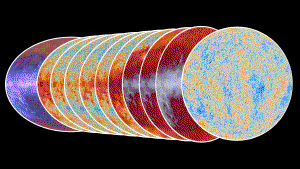Blog
Nine Skies
11 November 2014
 Planck Collaboration
Planck CollaborationThis month Astronomy & Astrophysics released 31 articles on data gathered by the Planck satellite.1 This includes nine all-sky surveys at a range of wavelengths from radio to infrared. It represents the most detailed map of the cosmic sky to date, and already there are some interesting results.
What makes the various sky-surveys useful is that each different wavelength gives a different view of the sky. For example, at the 1 cm range the radio emissions of our Milky Way galaxy tend to dominate. At the 300 micron level is the far infrared, which is where the signal of the infamous cosmic dust is strongest. In the middle range (around the 2 millimeter wavelength) is where the cosmic microwave background dominates.
From all these we can better distinguish the foreground effects (all the stars, galaxies, dust, etc.) from the distant cosmic background itself. This not only gives us a clear image of the cosmic background, it also gives us lots of data on all the foreground stuff. This isn’t just noise to be discarded. It actually helps pin down various cosmological parameters.
One of these parameters is the Hubble constant, which determines the rate of cosmic expansion. When we look at the redshift of galaxies, much of it is due to the cosmic expansion, but some is due to the motion of the galaxies through space (which is different). From redshift alone we can’t tell the difference, but the motion of galaxy clusters distorts the cosmic microwave background through what is known as the SZ effect. Basically, low energy photons from the cosmic background collide with fast moving electrons in a galaxy cluster. The photons are then scattered with a great deal of energy, thus changing their wavelength. We can see this as a shift in the wavelength distribution of the cosmic background in the region of the cluster. By measuring this effect we can distinguish between cosmic redshift and Doppler redshift.
Of course the big goal is the detailed mapping of the cosmic background itself, and this new work looks at that in detail. A few of the papers look at the possibility that the background isn’t quite the same in all directions, something that has been hinted at in earlier data, and seems to still be hinted at in this new data. Then of course there is the issue of early cosmic inflation, which entered the news when BICEP2 announced evidence of its existence, then had to tone down some of its claims. These new results put the strongest constraints on cosmic inflation thus far.
There’s a lot here. Far more than can be covered in a single post. As I work through the papers I’ll have much more to say. But that will have to wait for another day.
A&A special feature: Planck 2013 results. Astronomy & Astrophysics, volume 571, November 2014. ↩︎